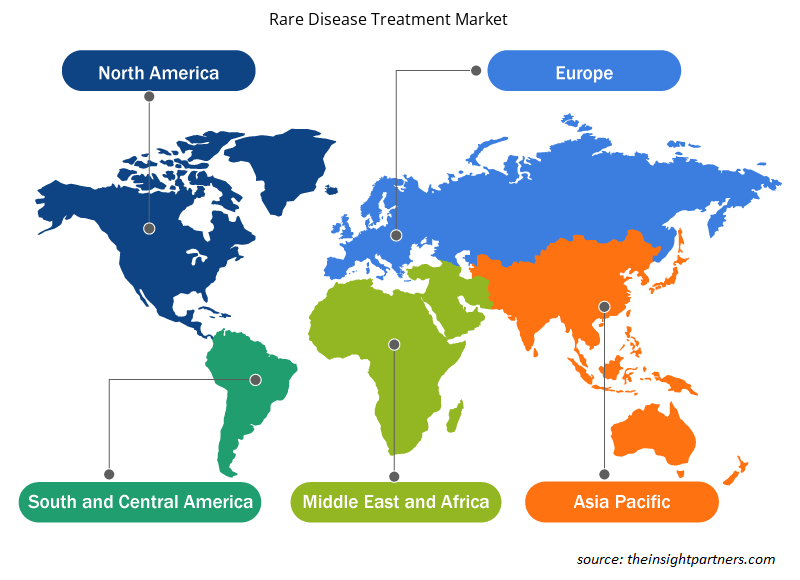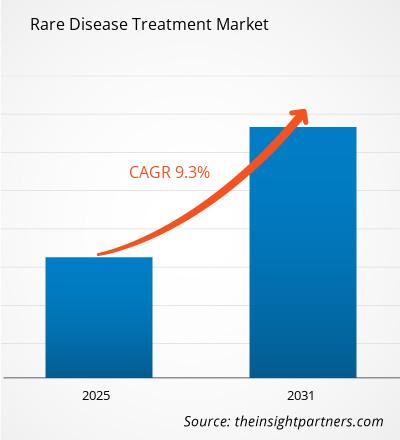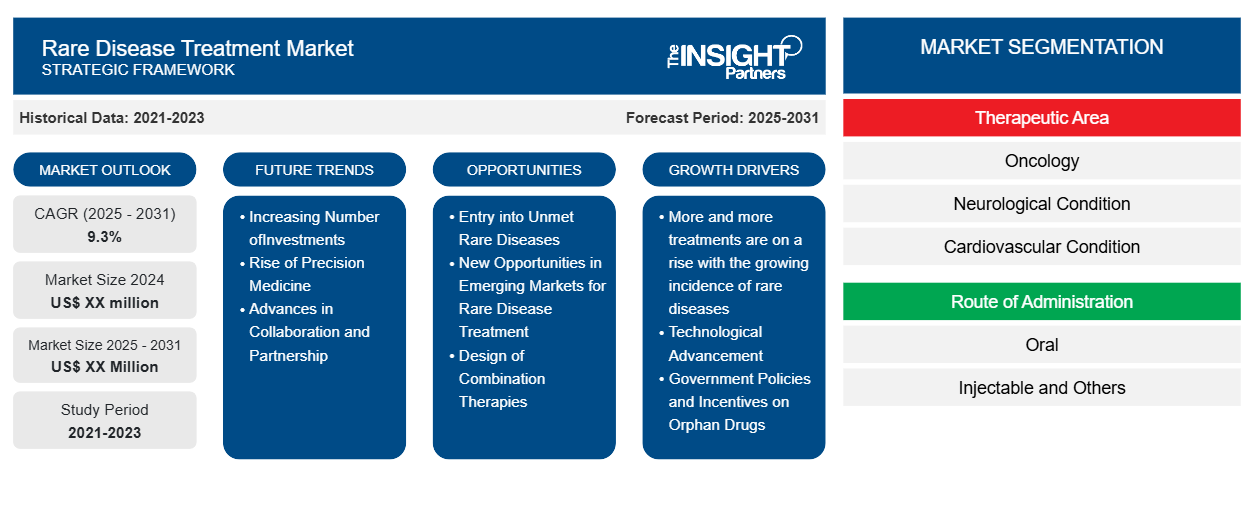希少疾患治療市場は、2024年から2031年にかけて9.3%のCAGRで成長し、市場規模は2024年のXX百万米ドルから2031年にはXX百万米ドルに拡大すると予想されています。
レポートは、治療領域(腫瘍学、神経疾患、心血管疾患、筋骨格疾患、感染症、その他)、投与経路(経口、注射、その他)、薬剤タイプ(生物製剤、小分子、バイオシミラー)および流通チャネル(オンライン薬局、専門薬局、病院薬局)別にセグメント化されており、
グローバル分析は地域レベルと主要国でさらに細分化されています。レポートは、上記の分析とセグメントに対して米ドルでの価値を提供します。
報告書の目的
The Insight Partners によるレポート「希少疾患治療市場」は、現在の状況と将来の成長、主な推進要因、課題、機会を説明することを目的としています。これにより、次のようなさまざまなビジネス関係者に洞察が提供されます。
- テクノロジープロバイダー/メーカー: 進化する市場の動向を理解し、潜在的な成長機会を把握することで、情報に基づいた戦略的意思決定が可能になります。
- 投資家: 市場の成長率、市場の財務予測、バリュー チェーン全体に存在する機会に関する包括的な傾向分析を実施します。
- 規制機関: 市場の濫用を最小限に抑え、投資家の信用と信頼を維持し、市場の完全性と安定性を維持することを目的として、市場における政策と警察活動を規制します。
希少疾患治療市場のセグメンテーション
治療領域
- 腫瘍学
- 神経学的状態
- 心臓血管疾患
- 筋骨格系の状態
- 感染症
- その他
投与経路
- オーラル
- 注射剤およびその他
薬剤の種類
- 生物学的製剤
- 低分子およびバイオシミラー
流通チャネル
- オンライン薬局
- 専門薬局と病院薬局
要件に合わせてレポートをカスタマイズする
このレポートの一部、国レベルの分析、Excelデータパックなど、あらゆるレポートを無料でカスタマイズできます。また、スタートアップや大学向けのお得なオファーや割引もご利用いただけます。
- このレポートの主要な市場動向を入手してください。この無料サンプルには、市場動向から見積もりや予測に至るまでのデータ分析が含まれます。
希少疾患治療市場の成長要因
- 希少疾患の発生率が高まるにつれて、治療法もますます増えています。医療において希少疾患を発見する成功率が高くなったことで、患者の診断精度が向上し、専門的な治療法の市場が拡大し続けています。特に、特別な治療を必要とする遺伝学、自己免疫、神経疾患は、非常に強みのある分野です。
- 技術の進歩: CRISPR 技術などのバイオテクノロジーと遺伝子編集技術の進歩により、希少疾患の治療方法が変わりました。遺伝性疾患の原因を標的とした遺伝子治療である高度な個人療法は、より高度な治療を促進します。そのため、需要に応える製薬会社と投資家は、希少疾患の治療における市場規模を拡大します。
- 希少疾病用医薬品に関する政府の政策とインセンティブ: 世界各国の政府は希少疾病用医薬品の開発を奨励する法律を制定しています。米国では、希少疾病用医薬品法に基づき、希少疾患の治療薬を開発する企業に減税、市場独占権、助成金が与えられる可能性があります。他の地域や EU のプログラムにより、希少疾病用医薬品への投資はより収益性の高いものとなりました。
希少疾患治療市場の将来動向
- 投資件数の増加: 希少疾患治療分野では遺伝子治療や細胞治療への投資件数が増加しており、この分野は嚢胞性線維症やデュシェンヌ型筋ジストロフィーなどの遺伝性疾患を中心に今後も成長が見込まれます。遺伝子治療や細胞治療の場合、これらの疾患の遺伝的原因に対処することで、治療や長期管理が可能になる可能性があります。これは希少疾患分野で見られる特定の傾向の 1 つです。
- 精密医療の台頭: 現在、希少疾患の治療における最新の決定的なトレンドの 1 つが精密医療です。ゲノミクス、特にバイオマーカーの特定における革命により、遺伝子プロファイルをターゲットにした治療の可能性は、特に希少疾患や複雑な疾患に対して効果的で集中的な治療となり、特定の遺伝子変異に正確に適用することで患者の転帰を改善し、薬剤の副作用を軽減することができます。
- コラボレーションとパートナーシップの進歩: 製薬会社は、希少疾患の潜在的な新しい治療法を見つけるために、学術界、バイオテクノロジー企業、患者支援団体と協力します。この点で、このようなコラボレーションは、新しい治療法の開発を迅速化するためにリソースと専門知識を共有します。また、これらのコラボレーション モデルは、官民パートナーシップの取り決めが続く希少疾患の分野でも繁栄するでしょう。
希少疾患治療市場の機会
- 満たされていない希少疾患への参入: 希少疾患は、そのほとんどに有効な治療法がないか、あるいはわずかな効果しか得られないため、製薬会社が注力できる広大な領域です。製薬会社は、希少がん、神経筋疾患、希少代謝障害などの領域における満たされていないニーズに注目することで、現在の治療法のギャップを埋め、革新的な治療法に対する需要が高い、収益性の高いニッチ市場を開拓することができます。
- 新興市場における希少疾患治療の新たな機会: 新興市場での医療へのアクセスのメリットが顕著になり、アジア太平洋、ラテンアメリカ、中東などの地域では希少疾患の治療に対する需要が高まっています。新しい治療法に対する認識と診断能力が高まっているため、企業にとってこれらの地域への進出を検討する絶好の機会となります。
- 併用療法の設計: 希少疾患のほとんどは複雑なため、多面的な治療プロセスが必要になる可能性があります。これにより、希少疾患に複数の側面を同時に影響させ、治療結果を向上させる併用療法を設計する機会が生まれます。これは、複数の薬剤によるアプローチが採用される希少がん、自己免疫疾患、遺伝性疾患などの疾患に非常に当てはまります。
希少疾患治療市場の地域別洞察
予測期間を通じて希少疾患治療市場に影響を与える地域的な傾向と要因は、Insight Partners のアナリストによって徹底的に説明されています。このセクションでは、北米、ヨーロッパ、アジア太平洋、中東およびアフリカ、南米および中米にわたる希少疾患治療市場のセグメントと地理についても説明します。

- 希少疾患治療市場の地域別データを入手
希少疾患治療市場レポートの範囲
| レポート属性 | 詳細 |
|---|---|
| 2024年の市場規模 | XX百万米ドル |
| 2031年までの市場規模 | XX百万米ドル |
| 世界のCAGR(2025年~2031年) | 9.3% |
| 履歴データ | 2021-2023 |
| 予測期間 | 2025-2031 |
| 対象セグメント | 治療領域別
|
| 対象地域と国 | 北米
|
| 市場リーダーと主要企業プロフィール |
|
希少疾患治療市場のプレーヤー密度:ビジネスダイナミクスへの影響を理解する
希少疾患治療市場は、消費者の嗜好の変化、技術の進歩、製品の利点に対する認識の高まりなどの要因により、エンドユーザーの需要が高まり、急速に成長しています。需要が高まるにつれて、企業は提供内容を拡大し、消費者のニーズを満たすために革新し、新たなトレンドを活用し、市場の成長をさらに促進しています。
市場プレーヤー密度とは、特定の市場または業界内で活動している企業または会社の分布を指します。これは、特定の市場スペースに、その規模または総市場価値と比較して、どれだけの競合相手 (市場プレーヤー) が存在するかを示します。
希少疾患治療市場で事業を展開している主要企業は次のとおりです。
- F.ホフマン・ラ・ロシュ株式会社
- ファイザー株式会社
- PTCセラピューティクス
- ノバルティスAG
- 武田薬品工業株式会社
免責事項:上記の企業は、特定の順序でランク付けされていません。

- 希少疾患治療市場のトップキープレーヤーの概要を入手
主なセールスポイント
- 包括的なカバレッジ: レポートでは、希少疾患治療市場の製品、サービス、タイプ、エンドユーザーの分析を包括的にカバーし、全体的な展望を提供します。
- 専門家による分析: レポートは、業界の専門家とアナリストの深い理解に基づいてまとめられています。
- 最新情報: このレポートは、最新の情報とデータの傾向を網羅しているため、ビジネスの関連性を保証します。
- カスタマイズ オプション: このレポートは、特定のクライアント要件に対応し、ビジネス戦略に適切に適合するようにカスタマイズできます。
したがって、希少疾患治療市場に関する調査レポートは、業界の状況と成長の見通しを解読し理解する道の先導役となる可能性があります。正当な懸念事項がいくつかあるかもしれませんが、このレポートの全体的な利点は欠点を上回る傾向があります。
- 過去2年間の分析、基準年、CAGRによる予測(7年間)
- PEST分析とSWOT分析
- 市場規模価値/数量 - 世界、地域、国
- 業界と競争環境
- Excel データセット
最新レポート
お客様の声
購入理由
- 情報に基づいた意思決定
- 市場動向の理解
- 競合分析
- 顧客インサイト
- 市場予測
- リスク軽減
- 戦略計画
- 投資の正当性
- 新興市場の特定
- マーケティング戦略の強化
- 業務効率の向上
- 規制動向への対応





















 無料サンプルを入手 - 希少疾患治療市場
無料サンプルを入手 - 希少疾患治療市場